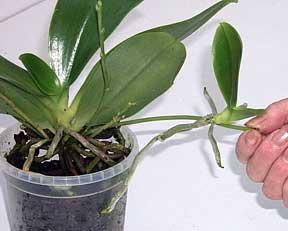 Lucky you. This type of growth is a bit unusual but it is a good thing. The growth is actually a new plantlet or offshoot which is called a keiki which is pronounced “kay-kee.” Keiki comes from the Hawaiian word for “baby.” Ultimately it can grow into a new flower spike.
Lucky you. This type of growth is a bit unusual but it is a good thing. The growth is actually a new plantlet or offshoot which is called a keiki which is pronounced “kay-kee.” Keiki comes from the Hawaiian word for “baby.” Ultimately it can grow into a new flower spike.
At first, it is small, like yours but it should soon develop roots and leaves. Once the keiki has several leaves and about the same number of roots then it will be time to repot it. The leaves should be at least 2-3 inches long before you should consider removing it. Taking it off too early will cause the keiki to die as it will not have enough food energy to be successful.
Not all orchids have the ability to produce these adventitious growths on vegetative parts of the plant. Phalaenopsis, Vanda, Dendrobium and Catasetum are a few of the better-known orchids producing easy to propagate keiki.
To remove the keiki take a sharp sterile knife and cut the plantlet just below the root tissue. Be careful not to remove any of the roots. It is critical to use a sterile utensil to minimize the potential for introducing disease. Consider painting the wounds on the mother plant and the keiki with a gentle fungicide to kill any potential disease pathogens. You can either repot the keiki in its own 4″ container or repot the mother plant. Keep the newly potted plant away from direct sunlight while it is getting established. A newly planted Keiki will take up to three years before it produces flowers.
One other important note: the presence of keiki can indicate the mother plant is under stress. However, the other plant appears healthy to you, then do not worry just keep a watchful eye on the orchid.
For more complete information on growing orchids check out the UF/IFAS website: http://gardeningsolutions.ifas.ufl.edu/plants/ornamentals/orchids.html
 2
2
